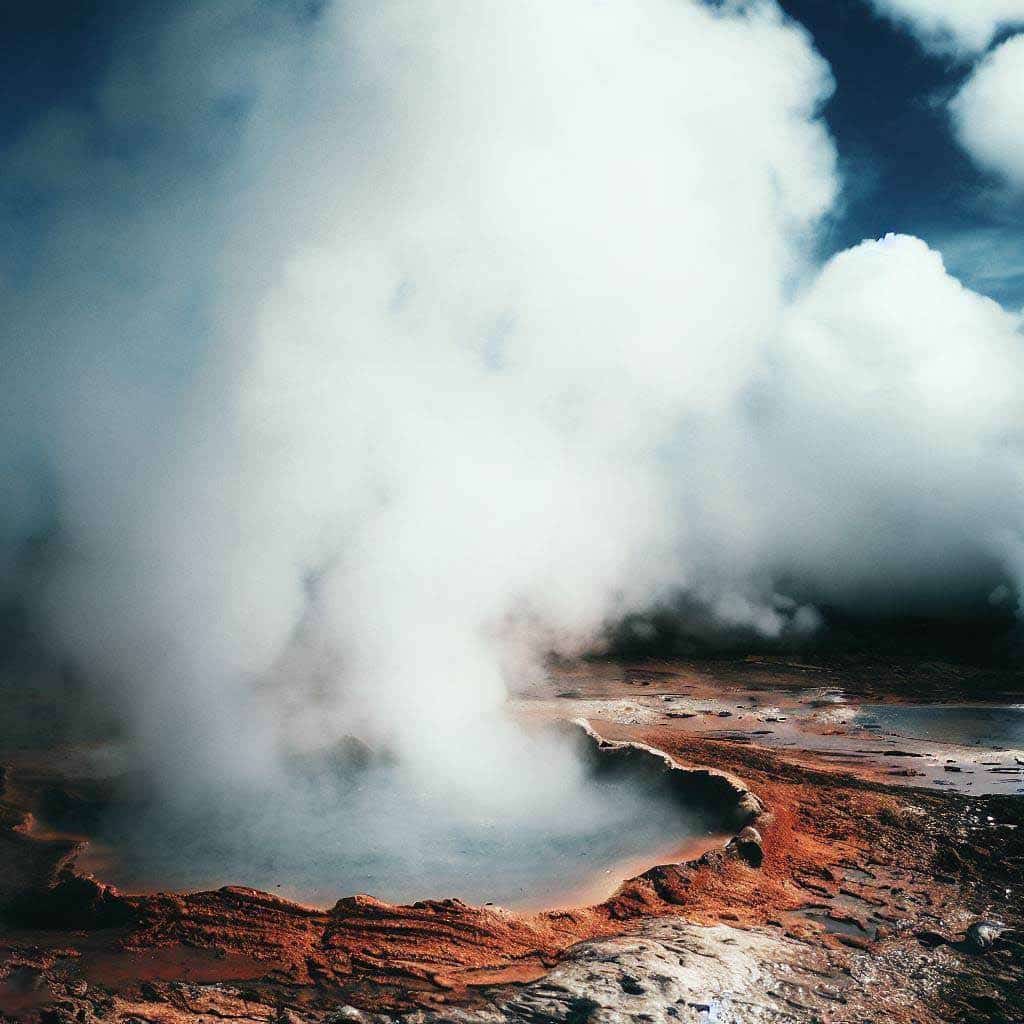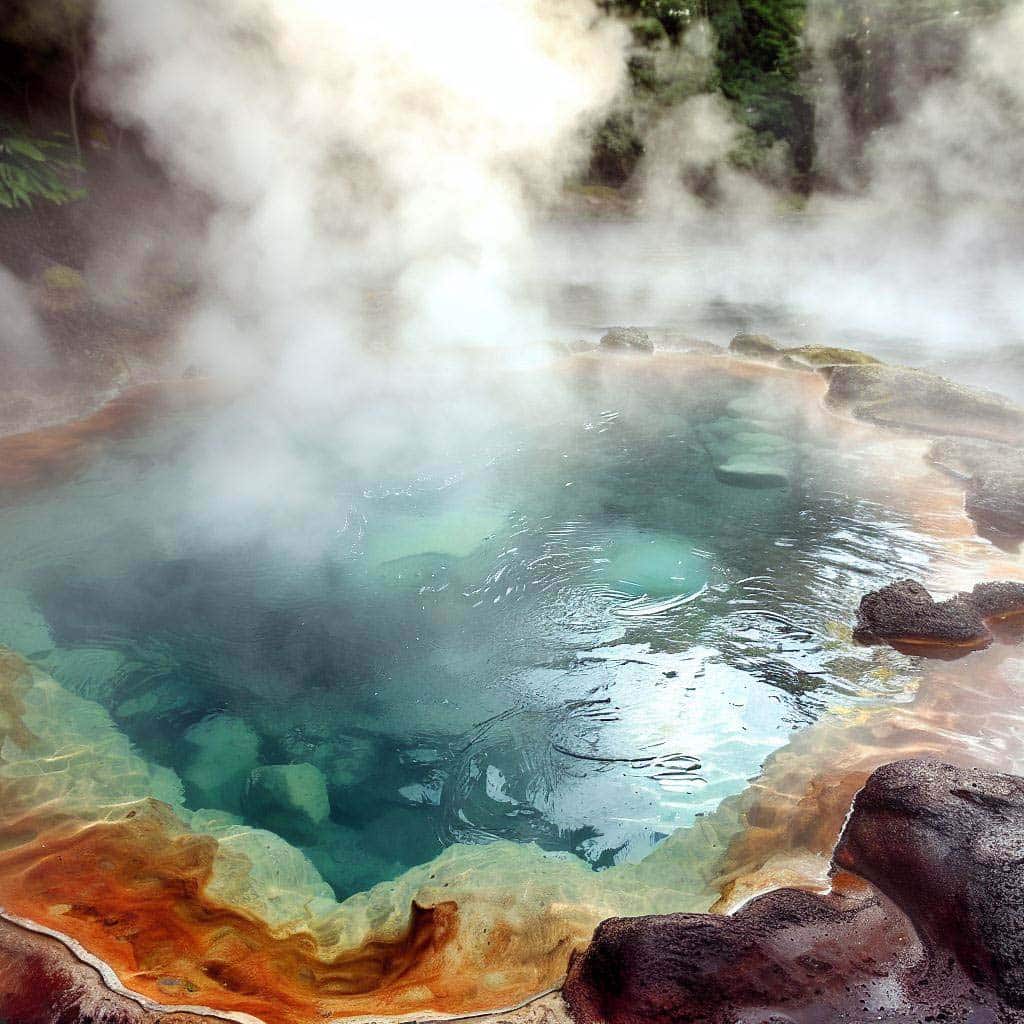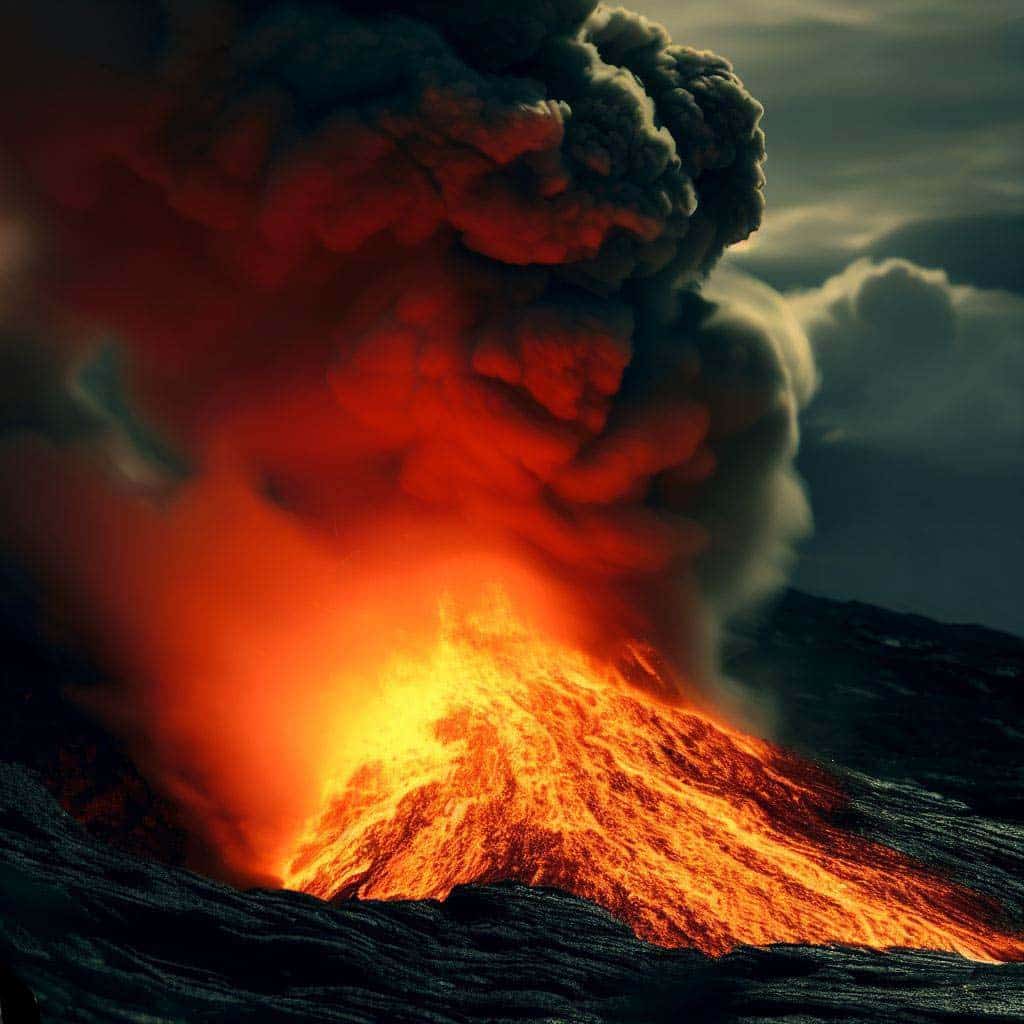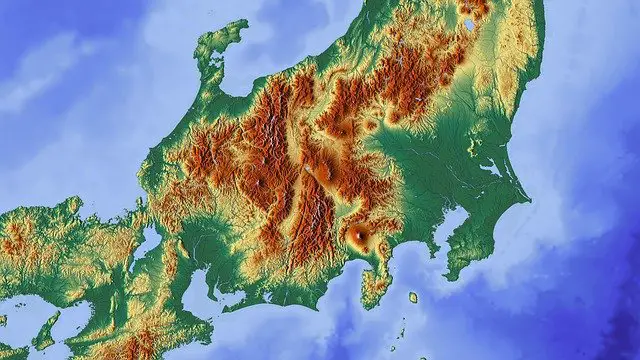Geothermal energy is a unique source of renewable energy that is generated from the heat within the Earth’s crust. It is a sustainable alternative to fossil fuels that has the potential to provide a significant portion of the world’s energy needs. Understanding the causes of geothermal energy is crucial in harnessing this source of power and creating a more sustainable future.
At the core of what causes geothermal energy is the Earth’s internal heat. The Earth’s interior is divided into several layers, each with its own unique properties. The outermost layer, the crust, is where geothermal energy is generated. The heat is a result of several factors, including the decay of radioactive isotopes, residual heat from the Earth’s formation, and convection currents in the mantle. This heat is then transferred to underground reservoirs of hot water and steam, which can be harnessed to generate electricity. With the potential to produce energy 24/7, geothermal energy has the potential to revolutionize the way we power our world.
Definition of Geothermal Energy

Moving on from the previous section, it is necessary to delve deeper into the concept of geothermal energy. Geothermal energy refers to the heat that is generated and stored within the Earth’s crust. This heat can be harnessed to create electricity or used to heat buildings directly. The term “geothermal” comes from the Greek words “geo,” meaning Earth, and “thermos,” meaning heat.
The energy is derived from the natural heat produced by the Earth’s core, which is believed to be around 6,000 degrees Celsius. This heat is transferred to the surface through conduction, convection, and radiation. The heat is present in the form of hot water and steam that can be extracted from the Earth and used to generate electricity. Geothermal energy is a renewable and sustainable source of energy because the Earth’s heat is constantly replenished.
Geothermal energy is one of the cleanest and most abundant sources of energy available on Earth. It provides a reliable source of energy that can be used to power homes, businesses, and industries without harming the environment. Moreover, it is also a cost-effective alternative to traditional fossil fuels because it eliminates the need for expensive and harmful extraction processes. As a result, geothermal energy has become increasingly popular as a source of renewable energy and is being used in many countries around the world.
Primary Cause of Geothermal Energy
Geothermal energy is an energy source that is unique in its origins and characteristics. The primary cause of geothermal energy is the decay of radioactive materials within the Earth’s crust, which releases heat into the surrounding rock. This heat is then transferred to the Earth’s surface, creating geothermal reservoirs that can be used to generate electricity or heat homes and buildings. Another factor contributing to geothermal energy is the heat released from the Earth’s core, which is estimated to be around 4,000-7,000 degrees Celsius. The amount of heat produced by these two factors combined is what makes geothermal energy a viable and sustainable energy source.
Decay of Radioactive Materials

As we continue our exploration of the causes of geothermal energy, the decay of radioactive materials stands out as a fascinating and critical element in understanding its primary cause. Radioactive decay is a natural process that emits energy in the form of heat and radiation. The decay of radioactive isotopes within the Earth’s core is the primary source of heat that drives geothermal energy.
The Earth’s core is made up of a complex mixture of different materials, including iron, nickel, and a variety of radioactive isotopes. These isotopes, such as uranium, thorium, and potassium, undergo spontaneous decay, emitting particles and energy in the process. This energy is released as heat, and over time, it accumulates to produce the tremendous heat that powers geothermal energy.
The amount of heat produced by radioactive decay is staggering. Scientists estimate that the heat generated by the decay of radioactive isotopes is approximately 30,000 times greater than the energy produced by the combustion of fossil fuels. This incredible amount of energy is continuously released from the Earth’s core, creating a virtually limitless source of geothermal energy. As we delve deeper into the science behind geothermal energy, it is clear that our planet’s natural processes have the potential to provide us with a sustainable source of energy for generations to come.
Heat Released from Earth’s Core
Transitioning from the previous section, the primary cause of geothermal energy is the heat that is released from the Earth’s core. This heat is generated by the decay of radioactive materials that are present within the Earth’s mantle and core. As these materials decay, they release energy in the form of heat, which is transferred to the surrounding rocks and eventually to the surface of the Earth. This heat is what drives the processes that create geothermal energy.
The Earth’s core is believed to be composed primarily of iron and nickel, with temperatures estimated to be around 5000°C. This extreme heat is generated by the energy released during the decay of radioactive isotopes, as well as from the residual heat left over from the formation of the Earth. This heat is transferred to the surrounding rocks through conduction and eventually makes its way to the surface of the Earth.
The amount of heat produced by the Earth’s core is staggering. It is estimated that the Earth’s core produces approximately 44 terawatts of heat energy, which is equivalent to the energy output of over 10,000 nuclear power plants. This heat energy drives the processes that create geothermal energy, and it is what makes geothermal energy such a valuable resource for producing electricity and heat. Understanding the heat released from the Earth’s core is essential for understanding the potential of geothermal energy, and for developing new technologies to harness this energy source.
Amount of Heat Produced
Transitioning from the primary cause of geothermal energy, the amount of heat produced by the earth’s core is a fascinating and unique aspect of this renewable energy source. The heat produced by the earth’s core is a result of the decay of radioactive materials and the release of their energy. This heat is constantly being produced and is estimated to be around 44 terawatts globally.
To put this into perspective, the amount of heat produced by the earth’s core is equivalent to the energy released by 44 trillion 100-watt light bulbs. Additionally, it is estimated that around 39 terawatts of this heat is lost through the earth’s crust and into the atmosphere, leaving around 5 terawatts of heat that can be harnessed and used as geothermal energy.
It is important to note that the amount of heat produced by the Earth’s core is not uniform across the planet. The highest areas of heat flow are found along tectonic plate boundaries, such as the Pacific Ring of Fire. These areas have a higher concentration of volcanic and geothermal activity, making them ideal locations for geothermal energy production. However, with advancements in technology, it is becoming increasingly possible to harness geothermal energy in areas with lower heat flow.
In summary, the amount of heat produced by the earth’s core is a unique and significant aspect of geothermal energy. While the majority of this heat is lost in the atmosphere, there is still a significant amount that can be harnessed and used as a renewable energy source. As technology continues to advance, it is likely that more areas will become viable for geothermal energy production, making it an increasingly important component of our global energy mix.
Secondary Causes of Geothermal Energy
Secondary causes of geothermal energy are influenced by various factors, including Earth’s Crust, Earth’s Atmosphere, and Ocean Currents. The Earth’s Crust plays a critical role in the production of geothermal energy as it is the source of heat. Meanwhile, the Earth’s Atmosphere contributes to the regulation of temperature and pressure, which affect geothermal energy production. Finally, Ocean Currents help distribute heat across the planet, affecting the temperature of groundwater and the intensity of geothermal vents.
Earth’s Crust
After understanding the primary cause of geothermal energy, it’s time to delve deeper into the secondary causes. One of the most significant secondary causes of geothermal energy is the Earth’s crust. The Earth’s crust is the outermost layer of the Earth and is composed of solid rock. It’s responsible for releasing heat from the interior of the Earth and is a vital component of geothermal energy.
The Earth’s crust is divided into two types: continental and oceanic crust. The continental crust is thicker and composed of lighter rocks such as granite, while the oceanic crust is thinner and composed of heavier rocks such as basalt. The difference in composition and thickness between the two types plays a crucial role in geothermal energy. The thinner oceanic crust allows more heat to escape from the Earth’s core, while the thicker continental crust retains more heat. This heat retention leads to the creation of geothermal reservoirs that can be tapped for energy.
The Earth’s crust is also responsible for the movement of tectonic plates, which is another source of geothermal energy. When two plates collide, the Earth’s crust is pushed together, and the pressure creates heat that is released as geothermal energy. This process is known as plate boundary geothermal energy, and it’s a significant source of geothermal energy in countries like Iceland and New Zealand. Understanding the Earth’s crust’s role in geothermal energy is crucial to harnessing this renewable energy source and reducing our reliance on non-renewable sources of energy.
Earth’s Atmosphere
As previously discussed, the primary cause of geothermal energy is the heat generated from the Earth’s core. However, there are also secondary causes that contribute to the production of geothermal energy. These include the Earth’s crust, atmosphere, and ocean currents. In this section, we will focus on the topic of the Earth’s atmosphere and its impact on geothermal energy.
The Earth’s atmosphere plays a crucial role in the production of geothermal energy. The atmosphere serves as an insulating layer that traps heat within the Earth’s surface. This heat is generated from the radioactive decay of elements such as uranium, thorium, and potassium. The heat is then transferred to the Earth’s surface through conduction, convection, and radiation.
The Earth’s atmosphere also affects the temperature of the Earth’s surface, which is an essential factor in the production of geothermal energy. The atmosphere absorbs and reflects solar radiation, which impacts the amount of heat that reaches the Earth’s surface. The amount of heat that is absorbed or reflected is influenced by various factors such as the Earth’s tilt, the presence of clouds, and the Earth’s albedo. These factors can impact the temperature of the Earth’s surface, which in turn affects the production of geothermal energy. Overall, the Earth’s atmosphere plays a vital role in the production of geothermal energy, and its impact cannot be overstated.
Ocean Currents
As we delve deeper into the causes of geothermal energy, it is important to note that the Earth’s ocean currents play a significant role in this natural phenomenon. Ocean currents are a continuous flow of water that moves in a particular direction, driven by various factors such as temperature, winds, and the Earth’s rotation. These currents carry vast amounts of heat, which can be harnessed to generate geothermal energy.
The ocean currents are formed due to differences in the temperature and salinity of the water. Warm water is less dense than cold water, and this causes it to rise to the surface, while the denser cold water sinks to the bottom. This movement of water creates a constant flow, which can be harnessed to generate electricity. In areas where the ocean currents are strong, such as in the Gulf Stream, the temperature difference between the warm and cold water can be as much as 20 degrees Celsius, making it an ideal source for geothermal energy.
In conclusion, ocean currents are one of the secondary causes of geothermal energy. These currents carry vast amounts of heat, which can be harnessed to generate electricity. Additionally, the Earth’s crust, specifically the layer of hot magma, plays a significant role in the generation of geothermal energy. As we continue to explore and understand the various causes of geothermal energy, we can develop sustainable and efficient methods of harnessing this natural resource for our energy needs.
Geopressured geothermal energy
Geopressured geothermal energy is one of the types of geothermal resources that are classified based on its source of heat. Unlike hydrothermal geothermal energy, which is heated by magma and is often associated with volcanic activity, geopressured geothermal energy is heated by pressure from sedimentary layers.
To understand how this works, it’s helpful to know a bit about the geology of sedimentary basins. Sedimentary basins are regions where layers of sediment (like sand, clay, and rock) have accumulated over time due to processes like erosion, weathering, and deposition. These layers can be thousands of meters thick and can contain organic matter like dead plants and animals, which can be converted into hydrocarbons like oil and natural gas.
As these layers of sediment accumulate, they can become buried under more and more sediment and rock. The weight of the overlying layers creates pressure, which compresses the sediment and causes it to become more dense. As the sediment becomes denser, it also becomes more impermeable, meaning that fluids like water and gas have a harder time moving through it.
However, the pressure and heat from the overlying layers can also cause the fluids in the sediment to become pressurized and heated. This can create a geopressured reservoir, where hot, pressurized water is trapped in the sedimentary layers. The water in a geopressured reservoir can reach temperatures of up to 150°C or higher.
To extract geopressured geothermal energy, a well is drilled into the reservoir. The hot, pressurized water is then brought to the surface, where it can be used to generate electricity or for other applications. Unlike hydrothermal geothermal energy, which typically requires a high-temperature gradient to be economical, geopressured geothermal energy can be extracted with a lower temperature gradient, making it potentially more widely applicable.
Geothermal Energy Sources
Geothermal energy sources are unique in their ability to harness the natural heat of the Earth. One way this heat is released is through geysers, which shoot hot water and steam into the air. Another manifestation is hot springs, where water is heated by underground volcanic activity and rises to the surface. Finally, the volcanic activity itself can be harnessed for energy, as magma heats surrounding rock and water to high temperatures.
Geysers

Moving on from secondary causes of geothermal energy, let’s have a look at the primary sources of this renewable energy. Geothermal energy comes from the heat generated by the Earth’s core and is found in various forms such as geysers, hot springs, and volcanic activity. In this section, we will focus on geysers and explore how they are formed and used for energy production.
Geysers are natural wonders that attract thousands of tourists every year. They are hot springs that intermittently shoot up steam and hot water into the air, often reaching heights of several meters. Geysers are rare and can only be found in a few locations worldwide, including Yellowstone National Park in the United States, Iceland, New Zealand, and Chile. The formation of geysers is a complex process that requires certain geological conditions, including a reservoir of hot water, a source of heat, and a confined space that allows pressure to build up.
Geysers are not only a sight to behold but also a valuable source of geothermal energy. The heat and pressure generated by the volcanic activity underneath the Earth’s surface is harnessed by drilling wells and pumping water into the underground reservoirs. The heated water rises back to the surface in the form of steam, which powers turbines and generates electricity. The use of geysers for geothermal energy is a sustainable and renewable alternative to fossil fuels and has the potential to provide a significant portion of the world’s electricity needs.
Hot Springs

As discussed in the previous section, geothermal energy can be generated from a variety of secondary causes. In this section, we will focus on the source of hot springs as a potential geothermal energy source. Hot springs are natural bodies of water that are heated by the Earth’s geothermal heat. They are found in many parts of the world, including Yellowstone National Park in the United States, the Geysers in California, and the Taupo Volcanic Zone in New Zealand.
Hot springs are formed when water seeps into the ground and comes into contact with rocks that are heated by the Earth’s geothermal heat. The water is then heated and rises to the surface in the form of a hot spring. The temperature of hot springs can vary widely, ranging from just a few degrees above the surrounding water temperature to boiling hot. The water in hot springs is often rich in minerals, which can have therapeutic properties and make them popular tourist destinations.
In addition to their recreational and therapeutic uses, hot springs can also be used as a source of geothermal energy. The heat from hot springs can be used to generate electricity through the use of geothermal power plants. The process involves pumping the hot water from the hot spring into a power plant, where it is used to heat a working fluid, such as a refrigerant or a binary fluid, which then drives a turbine to generate electricity. The cooled water is then returned to the ground, completing the cycle. With the growing demand for renewable energy sources, hot springs have the potential to become an important source of geothermal energy in the future.
Volcanic Activity

Moving on from the secondary causes of geothermal energy, it’s now time to examine the various sources of this renewable energy. Geothermal energy is primarily derived from three sources: geysers, hot springs, and volcanic activity. While geysers and hot springs are formed due to the heating of groundwater by geothermal heat, volcanic activity is a direct result of the Earth’s internal heat. In this section, we will focus on the role of volcanic activity in geothermal energy production.
Volcanic activity is one of the most significant sources of geothermal energy. The heat generated by magma and hot rocks deep within the Earth’s mantle is transferred to the Earth’s surface through volcanic activity. This heat is then used to generate steam, which is used to power turbines and produce electricity. Volcanic activity can also create geothermal reservoirs that can be accessed through drilling, allowing for the extraction of geothermal energy.
Volcanic activity can also be harnessed through the use of binary cycle power plants. These power plants use the heat from volcanic activity to heat a secondary fluid with a lower boiling point than water. This fluid then turns into vapor, which is used to turn turbines and produce electricity. This method of geothermal energy production is highly efficient, as it allows for the extraction of geothermal energy from low-temperature sources. Furthermore, the use of binary cycle power plants greatly reduces the risk of subsidence and other geological hazards associated with geothermal energy production.
In conclusion, geothermal energy is a unique and reliable source of renewable energy that is gaining popularity around the world. It is generated by the Earth’s internal heat, which is primarily caused by the decay of radioactive isotopes and is further influenced by secondary factors such as tectonic activity and heat flow through the Earth’s crust. This energy source can be harnessed through geothermal power plants, direct-use applications, and ground-source heat pumps.
Geothermal energy is a promising alternative to traditional fossil fuels, with significant benefits such as reduced greenhouse gas emissions, lower operating costs, and increased energy security. However, like any energy source, it has its limitations and challenges, including the need for suitable geothermal resources, potential environmental impacts, and high upfront costs. Despite these challenges, geothermal energy remains an important part of the renewable energy mix and has the potential to play a significant role in meeting the world’s energy needs in a sustainable and environmentally friendly way.



[…] Geothermal energy is an increasingly popular renewable energy source that harnesses the Earth’s natural heat. Geological engineers are vital in the development of geothermal energy projects, as they need to assess the geological conditions of a site to determine the potential for geothermal energy production. They also design and monitor the construction of geothermal wells and other infrastructure required for harnessing the Earth’s heat. […]